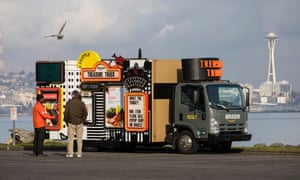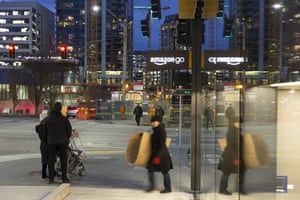
The buzz of a text message heralds the latest offer on Amazon’s Treasure Truck – a funky lorry bedecked with funfair lights and retro signs that appears at random in the streets of Seattle with a one-off discounted product for sale.
Alaskan cod, four fillets for $17, was the most recent item; a few days earlier it was two 16oz prime steaks for $40. Click on your Amazon app to buy your “treasure” and you’ll be told where the truck is so you can pick it up.
“It’s fun,” says Nicole Jamieson, 42. “My kids love it because it looks cool with all its lights flashing. You need to move fast, though – they sell out quickly.”
The truck, which launched a year ago, is stocked several times a month with deals that range from turkeys to Nintendo game consoles. There are rumours it will appear in London soon.
The Treasure Truck is a quirky manifestation of Amazon’s recent foray into the physical world it once shunned. In late 2015 it opened a book shop in a Seattle mall, and it is currently piloting two types of supermarket in the city, Amazon Go, a hi-tech convenience store, which eliminates the need to queue at a checkout, and AmazonFresh Pickup, where orders placed online can be picked up within 15 minutes at a drive-through. These are currently in beta mode, open only to employees.
Amazon’s home town of Seattle is, in effect, its laboratory for its bricks-and-mortar retail experiments. Once glitches have been dealt with, these new stores may be rolled out – there are now five bookshops in the US, with plans for seven more.
AmazonFresh vans, delivering groceries ordered online, can be spotted all over the city – another concept trialled in Seattle that was fine-tuned for years before being introduced elsewhere. These latest appearances of the company logo, with its swooshing arrow from the A to the Z, make the company’s presence ever more felt.
Not everyone welcomes it. For some, it is mainly Amazon, which now employs 25,000 people in Seattle, that is to blame for the changing character of the city.
Jeff Reifman, a consultant and writer, says: “I’m spending [less time in Seattle] now, and Amazon has a lot to do with that. Since 2010 Amazon has been increasing exponentially. There’s a huge impact on traffic, the cost of housing, the affordability.”

When he first moved to the city 25 years ago, he says there was “a slower pace”. “There was a connection to nature, a lefty awareness, a hippy culture, a focus on literature and the arts. Seattle is becoming one of the world’s greatest cities, but success has a cost in that it doesn’t have a rich cultural flavour to it.”
Others, however, feel differently. At the Amazon bookshop one weekday lunchtime, Tiffany, a digital advertising executive in her 40s, was browsing for holiday reads. “I find it exciting for Seattle to have a new influx of people and ideas. It’s good for the city. It’s super-interesting seeing what they test here. I’m an avid Amazon user – as a mom it makes my life so much easier. I’ll certainly try Pickup and Go when they open.”
Analysts say that Amazon is experimenting with bricks-and-mortar projects so it can capture a bigger chunk of certain retail markets.
The bookshops are an attempt to attract those customers who prefer to browse in person. While doing so, they’re encouraged to become a $99-a-year Amazon Prime member, which gives free online delivery and extras that include being able to pay the cheaper website price for a book in the shop.
But the bigger prize is the grocery market, which has been slow to move online. Online delivery accounts for only 1.4% of food sales in the US and 6.9% in the UK. Many shoppers want to see fresh fruit, vegetables and meat before they buy; others do not want to pay a delivery charge, and then there is the vast size of the US and the logistical issues that brings.
Don Stuart, a managing partner at Cadent Consulting Group, says: “The $800bn-plus grocery market is the Goliath, and Amazon would like to penetrate it more deeply than it can with just Prime or different types of direct online e-commerce activity.”
Clearly, Amazon has competition from behemoths such as Walmart, and Seattle is where it is testing its battle plans. “It’s right in their backyard,” says Stuart. “They can keep an eye on things every day, control it, change the variables that they’re testing.” As Amazon spokeswoman Nell Rona puts it: “Experimenting close to customers here helps us innovate and learn faster in the early stages.”
The AmazonFresh PickUp store on a busy main road in Ballard, an area that has seen rapid gentrification in recent years, was unveiled last month. The concrete and wood-clad building has a glass foyer with “Hello Ballard” in foot-high white letters on the window. A steel canopy protects parking slots where drivers pull in to pick up their shopping. A notice on a sandwich board says: “Beta Participant Entry”. A man in a green apron, holding a clipboard, stood outside last week. “It’s not open to the public yet,” he told people who wandered up. “You’ll sure hear about it when it is.”
Some in the neighborhood aren’t so bothered. Ian Spicknall, 36, a taxi driver, says: “I prefer to go to the store and spend an hour or so choosing what I want, looking at prices. It’s hard to look at groceries on a tablet. It’ll be good for certain types of people, like mini-van moms, being able to pick up their groceries on the way home.

“I think they’re for people of a certain income – probably tech industry workers. I like mom-and-pop shops, the backbone of America, and you feel like you are supporting the community. Seattle is a lot about being green, going hiking, and breweries. People like to shop local.”
Spokeswoman Nell Rona says: “We have all kinds of customers, who shop in various ways, who look for a wide range of items, and do so on any number of different occasions. As a result, we’ve created a variety of innovative services that satisfy customers’ different needs as it relates to grocery shopping.”
In response to criticisms of Amazon’s dominating presence in Seattle, she says: “We’ve made a long-term commitment to invest in the city of Seattle. From unique retail space on the ground floor of all our buildings to public spaces nearby – such as an outdoor dog park, playing fields, a shared-use street that’s designed to be great for pedestrians as well as cars, art installations, covered public walkways and other amenities.”
Brendan Witcher, a retail and e-commerce analyst at Forrester, says Amazon was trying to do to the grocery industry what Apple did to the music industry. “They’re trying to create a full grocery-to-home ecosystem. Starting with Alexa [Amazon’s digital personal assistant]. I can say: “Alexa, send me my groceries list minus garlic and tomatoes.” By having locations, Alexa can say to me: “Would you like them to ship or to pick up?” Done.
“Amazon will own the device you order from; own the method of delivery; own all the products in that category; own multiple ways to get those products.”
The Alexa tool is what other retailers should be most worried about, he says. “That is a critical difference in the customer journey that can allow Amazon to own so much of this space. That compares to me finding my phone or laptop, opening it up, logging in, going on the website, putting things into my shopping cart and checking out. Any time we see a huge amount of friction removed from the customer journey, we see adoption.”
Success is not guaranteed though. “Just because Amazon is a great online retailer doesn’t mean it will instantly jump into physical and be amazing at it: they still need to learn about labour, traffic flows, real estate, perishable items in the store environment, security… all these things they didn’t have to worry about as an online retailer.”
Amazon Go has been in beta mode since December and was due to open early this year. Shoppers scan their apps on entering the shop, put what they want in their bags and walk out. No need for checkouts, card transactions or bagging. Nor for cashiers, of whom there are 3.5 million in the US (the United Food and Commercial Workers International Union, which represents grocery store workers, has strongly criticised the stores).
The Wall Street Journal has reported that the technology has been crashing in tests when the store is too crowded.
If these hitches can be solved, Neil Stern, senior partner at retail consulting firm McMillanDoolittle, believes that Amazon Go could be a game changer for every segment of retail because the technology is not food-specific. He wrote in a blog: “The proposition for the consumer is simple – save time and hassle. The proposition for retailers may be even more compelling – save labour on the biggest component of the store (the front end) as well as improve throughput.
He told the Observer that Amazon had an enormous advantage over other retailers because 40% of US households were Prime members. “They know who their customers are already, they have credit and payment [details] for their customers, and their buying preferences.”
Not that he thinks all Amazon’s ideas will have the same impact. “Take the Treasure Truck – it’s fun and gimmicky. Jeff Bezos [the founder and CEO] is a master of public relations, and getting people excited about an idea before it’s commercially viable, including the truck and the Amazon bookstore.”
Amazon is not the only global brand using Seattle as a Petri dish. Among other initiatives, Starbucks has trialled its high-end coffee house, the Reserve Roastery, which will now open in several major cities worldwide.
Innovation is threaded into Seattle’s DNA, according to Leonard Garfield, executive director of Seattle’s Museum of History and Industry. “In 1852 Henry Yesler was invited into the community of fewer than 100 people because he had a sawmill that was different to any other around. That initial technological innovation distinguished Seattle from any other of these small villages popping up in the woods of the north-west.
“You can see it again with Bill Boeing and again with Bill Gates, and it keeps repeating itself – relatively young people who are willing to embrace the new technology, willing to take a risk and willing to invite people to the table who are different than the people already here.”
He acknowledges that there has always been a counter-narrative to this. When Microsoft and Boeing were booming a few decades ago, there were people “who weren’t any too enthusiastic about lots of young tech people coming in and maybe changing a little bit of the character.
“That scene has been there, but at the end of the day I think it’s a community where the smart idea has always won out.”
Time will tell whether any of Amazon’s trial projects will be smart ideas.
No comments:
Post a Comment